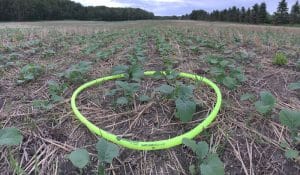Plant counts can influence management decisions for the current crop (if counts are low, you’ll need to protect all of those plants) and for next year’s seeding rate and plant protection decisions. Plant counts are an important part of the checklist for your post-emergence assessments. Missing plants? What’s the cause?
An accurate average plant stand count will determine whether crop establishment measures achieved the target goal, and scouting can help understand why or why not. How many plants did you expect based on the seeding rate? Is the plant stand in line with this expectation? Answers to these questions will help growers improve stand establishment practices for next year, and help with management decisions for the current crop.
To do counts…
Use a 50 cm by 50 cm square or a hoop with an inside diameter of 56 cm. Both are the equivalent of 0.25 of a square metre. Count the number of plants inside the square or hoop, and multiply by 4 to get plants per square metre. (for plants per square foot use a one foot square or divide the plants per square metre by approximately 10).
Another method is to use a metre stick and count the seedlings per metre of row. Take that number and multiply by 100 then divide by the row spacing in cm to get plants per square metre. For example, 25 plants per metre multiplied by 100 then divided by 25 cm (10” row spacing) is 100 plants per square metre (approximately 10 per square foot).
For all methods, several counts per field are required to get a good representative average.
Fields should be monitored and walked starting 10 days after seeding if conditions are good, or 15 days if conditions are cool. If the plant stand is less than expected for the given seeding rate, seed size and estimated seedling survival, then check equipment settings, seed characteristics and field conditions to identify why the ideal plant population was not achieved.
The cause or causes may relate to the seeding operation, such as inconsistent depth, excess fertilizer placement with seed, or mechanical issues. Frost, wind or flooding, insects or disease, or herbicide residues could also be factors.
When stands are spotty and thin, careful management is required to preserve the plants present. More conservative thresholds may be warranted for insects, weeds and diseases.


